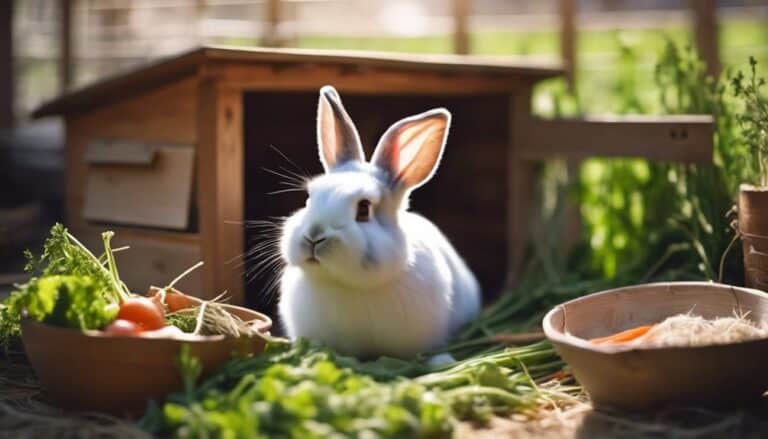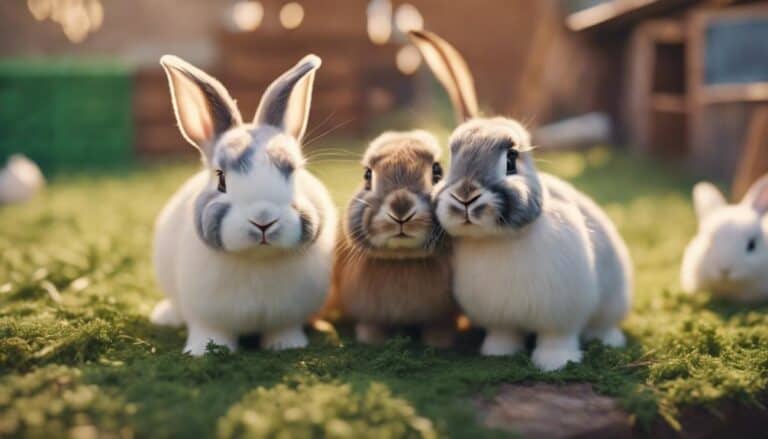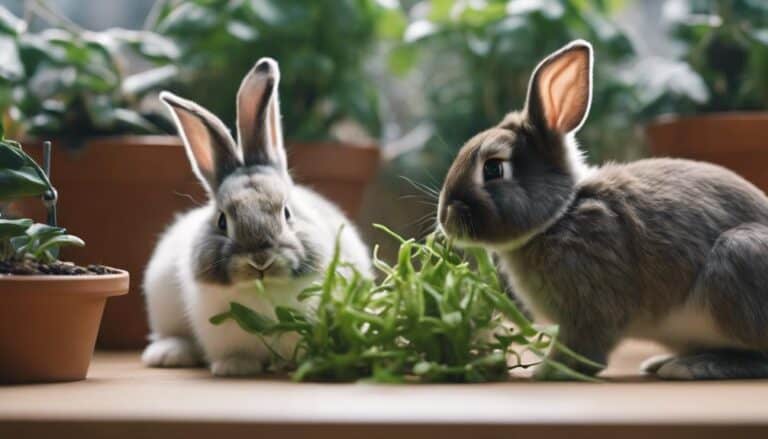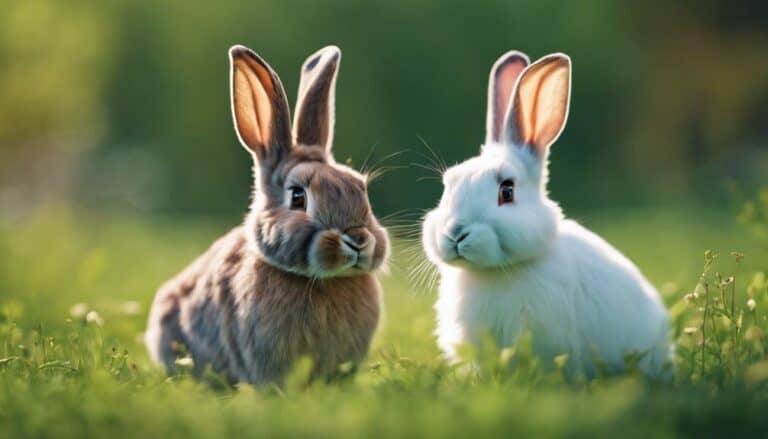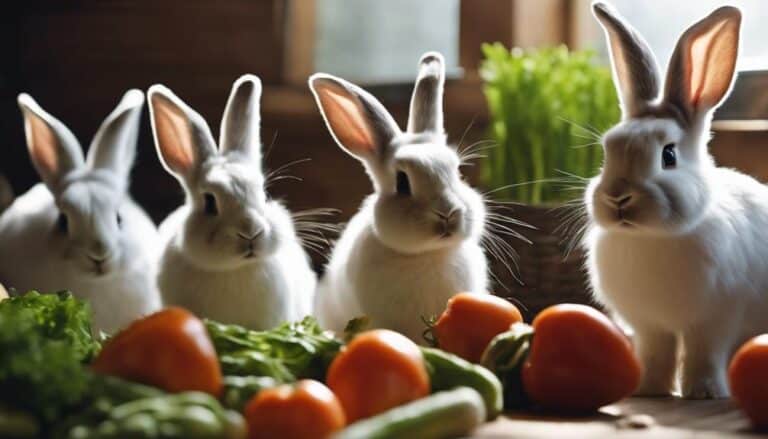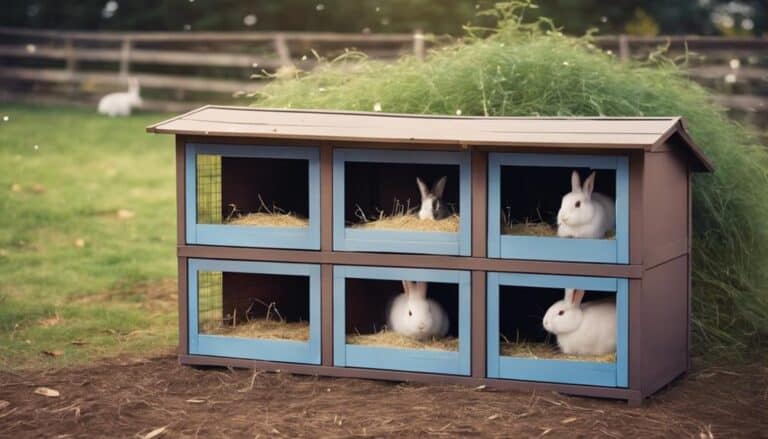When it comes to bunny reproduction, you might be surprised by the various challenges that can arise. From dealing with age-related fertility issues to ensuring the right timing for breeding, there are many factors to think about.
Behavioral challenges, reproductive health concerns, and environmental influences all play a role in successful bunny reproduction. As you explore deeper into this topic, you'll discover how intricate the world of bunny breeding can be and how important it is to navigate these challenges effectively to achieve desired outcomes.
Contents
Key Takeaways
- Behavioral challenges like shy buck syndrome and fatigue can hinder successful mating.
- Genetic factors such as dental malocclusion and splay leg syndrome affect reproduction.
- Environmental factors like temperature and lighting play a significant role in fertility.
- Nutritional balance with essential nutrients is crucial for optimal breeding outcomes.
Age and Timing for Breeding
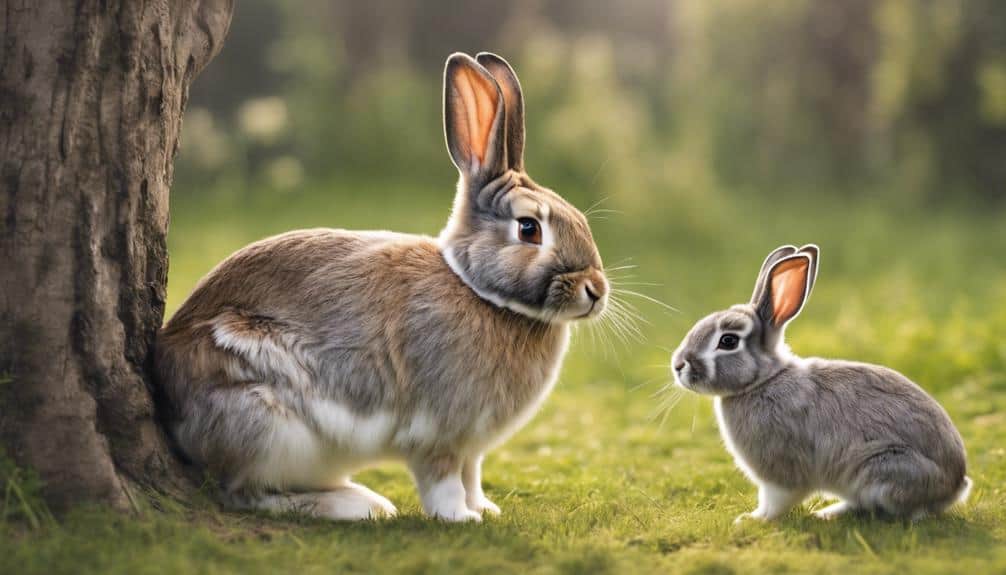
When considering the age and timing for breeding rabbits, it's important to understand the specific maturity milestones for different breeds to guarantee successful reproduction.
Female rabbits can be bred as early as 5 months old, but males should wait until they reach at least 6 months. Smaller rabbit breeds, like dwarfs, may be ready for breeding around 4 to 5 months, while larger breeds, like Flemish Giants, might need to wait until they're 7 months old.
It's essential to note that females generally mature faster than males, enabling does to enter the breeding phase before bucks of the same age. This difference in maturation rates should be considered when planning the timing of breeding to ensure best outcomes.
Monitoring the age, maturity, and readiness of your rabbits before mating is critical in the breeding process to maximize the chances of successful reproduction. By being attentive to these factors, you can help facilitate a smooth and productive breeding experience for your rabbits.
Behavioral Challenges in Mating
Amidst the intricate world of rabbit reproduction, traversing through the behavioral challenges in mating requires a keen understanding of various factors influencing successful breeding outcomes. Bucks losing interest, commonly known as shy buck syndrome, can hinder mating behavior, leading to decreased breeding success.
Additionally, bucks may tire quickly during mating, affecting their ability to successfully breed with does. Vent disease in bucks is another behavioral challenge that can cause discomfort, impacting their willingness to engage in mating activities.
High temperatures, especially during summer months, can make rabbits reluctant to breed, further complicating the mating process. Inexperience, particularly in virgin does, poses a challenge as they may struggle to engage in successful mating behaviors.
Recognizing and addressing these behavioral challenges are vital in overcoming obstacles and promoting successful bunny reproduction.
Reproductive Health Concerns
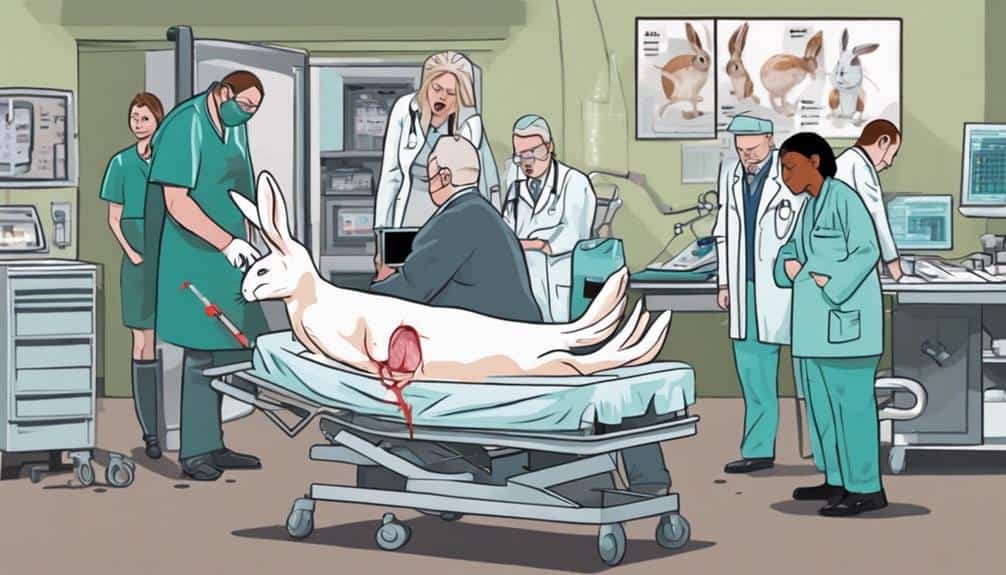
If your buck shows disinterest in mating, there might be underlying health issues affecting its reproductive health.
To address potential concerns, check your buck's vent for signs of discomfort that could impact breeding behavior.
Injuries, soreness, digestive problems, or illnesses can all hinder successful reproduction and breeding behavior.
Breeding Challenges
Examine the buck's behavior closely for any signs of underlying health issues that may be affecting its breeding interest and performance. A lack of interest from the buck in the female rabbit can be a red flag for potential reproductive health concerns.
In intensive breeding programs, monitoring the buck's cage for any injuries or signs of soreness is essential for successful mating and best reproductive performance. Additionally, digestive issues or illnesses in the buck can greatly impact its libido and fertility.
Regularly checking the buck's vent for signs of discomfort is necessary to guarantee smooth breeding processes. Unattended breeding risks can lead to unexpected pregnancies, emphasizing the need for supervision during mating to prevent any potential health risks.
Fertility Issues
To guarantee ideal fertility in rabbits, proper management of environmental factors such as ambient temperature and light exposure is essential for successful breeding outcomes.
When addressing fertility issues in rabbits, consider the following key points:
- Low and high ambient temperatures can impact fertility rates in rabbits, affecting their ability to conceive.
- Maintaining 14 to 16 hours of light exposure daily is critical for best breeding success in rabbits.
- Proper nutrition, including complete compound feed and natural vitamin supplements, is necessary for ensuring good reproductive health in rabbits.
- Female rabbits need to be in excellent physical condition to support successful mating and reproduction.
- Observing the condition of a rabbit's external genitals can help determine the best timing for mating to maximize reproductive success.
Genetic Disorders Impacting Reproduction
Genetic disorders, such as dental malocclusion or limb deformities, can severely impact a bunny's reproductive capabilities. Inherited conditions like splay leg syndrome or respiratory issues may pose challenges for successful breeding in bunnies.
Ensuring proper genetic screening and avoiding breeding pairs with known genetic disorders is vital to prevent passing on detrimental traits to offspring.
Genetic Reproductive Challenges
In the domain of bunny reproduction, challenges stemming from genetic disorders impacting fertility and reproduction are a crucial consideration for breeders. Genetic reproductive challenges can greatly influence the breeding success and reproductive health of bunnies.
Here are some key points to note:
- Genetic mutations can lead to fertility issues in bunnies.
- Reproductive disorders caused by inherited genetic abnormalities can hinder successful breeding.
- Hereditary issues affecting reproductive organs may result in difficulties during the breeding process.
- Breeders must be mindful of potential genetic reproductive challenges to make informed decisions.
- Employing genetic testing and selective breeding strategies can help manage and reduce the impact of genetic reproductive challenges within bunny populations.
Inherited Fertility Issues
Exploring the world of bunny reproduction, one significant aspect to address revolves around the impact of inherited fertility issues stemming from genetic disorders on the reproductive capabilities of these animals. Inherited fertility challenges can arise from genetic disorders affecting the proper function of reproductive organs in rabbits. Conditions like cryptorchidism in males and uterine anomalies in females are common genetic disorders that can hinder fertility.
Genetic mutations may lead to reduced fertility, irregular estrous cycles, or even infertility in rabbits. It's important to be cautious when breeding rabbits with known genetic disorders, as this can perpetuate fertility issues in future generations. Utilizing proper breeding selection methods and genetic testing can help identify and mitigate inherited fertility challenges in rabbit reproduction.
Reproductive Genetic Disorders
Reproductive health in rabbits can be greatly influenced by various genetic disorders that impact their ability to reproduce successfully. When dealing with reproductive genetic disorders, it's important to bear in mind the following:
- Uterine anomalies
- Testicular defects
- Chromosomal abnormalities
- Hereditary nature of genetic disorders
- Significance of genetic testing
Understanding these genetic factors is essential for maintaining the best breeding performance and ensuring the health of rabbit populations.
Environmental Factors Affecting Fertility
When considering environmental factors that impact fertility in rabbits, it's important to address the effects of ambient temperatures and light exposure on breeding success. Ambient temperatures above 85 degrees Fahrenheit can lead to heat-induced sterility in male rabbits, affecting their ability to successfully breed. Exposure to 14 to 16 hours of light per day is vital for optimizing fertility and breeding success in rabbits. Maintaining the right conditions, including regulating ambient temperatures and ensuring proper lighting, can greatly improve the chances of successful mating and reproduction.
In addition to environmental conditions, providing proper nutrition is essential for maintaining fertility in rabbits. Ensuring a balanced diet with complete compound feed and natural vitamin supplements can play a significant role in supporting reproductive health. Monitoring feed intake and the physical condition of female rabbits is crucial for successful mating and breeding outcomes. By paying attention to these environmental factors and providing adequate care, you can help maximize the fertility and breeding success of your rabbits.
Nutritional Challenges in Breeding

Considering the impact of environmental factors on rabbit fertility, it becomes evident that addressing the nutritional challenges in breeding is paramount for ensuring successful reproduction and overall health in your rabbits. Proper nutrition plays an important role in the breeding process, directly influencing reproductive performance and the well-being of both the parent rabbits and their offspring.
To overcome nutritional challenges in rabbit reproduction, here are some key points to focus on:
- Ensuring a balanced rabbit diet rich in essential nutrients such as proteins, vitamins, and minerals is important for supporting fertility and gestation.
- Providing high-quality hay, fresh water, and commercial rabbit feed as essential components of a well-rounded breeding rabbit diet.
- Preventing fertility issues, low birth weights, and poor survival rates of offspring by addressing inadequate nutrition.
- Offering natural vitamin supplements can help bridge any nutritional gaps in the rabbit's diet.
- Access to a complete compound feed can further support the nutritional needs of breeding rabbits, promoting successful reproduction and overall health.
Management of Breeding Pairs
Properly managing the pairing of breeding rabbits is essential for ensuring successful reproduction and maintaining the health of the rabbits involved. When selecting breeding pairs, consider the compatibility between the buck and doe. Observing their behavior and interactions is important; make sure they aren't aggressive towards each other.
Creating a stress-free environment for the breeding pairs can greatly improve fertility rates. Provide spacious, clean living quarters with adequate food and water to reduce any potential stressors. Regularly monitor the rabbits' health and condition to address any issues promptly. If you notice any signs of illness or distress, separate the pair to prevent further complications.
Frequently Asked Questions
What Are the Problems With Breeding Rabbits?
Breeding rabbits may encounter health issues, genetics problems, environmental factors, breeding complications, and reproductive failures. It's important to monitor behaviors, weight, and provide ample space for successful breeding, ensuring the well-being of your bunnies.
What Are the Challenges Faced in Rabbit Production?
To excel in rabbit production, focus on meeting nutrition needs, addressing health concerns promptly, providing best housing, selecting superior genetics, and mastering breeding techniques. Aim for excellence in each area to enhance overall success.
What Are Three Disadvantages of Rabbit Production?
In rabbit production, common challenges include health concerns, genetic diversity limitations, and meeting nutritional needs. Housing constraints and reproductive issues further complicate operations. Balancing these factors is essential for successful bunny breeding and overall herd management.
Why Are My Rabbits Not Reproducing?
If your rabbits are not reproducing, consider evaluating their breeding techniques, health issues, stress levels, genetics, and mating habits. Monitoring their well-being, adjusting environmental factors, and selecting suitable breeding pairs can enhance success rates in reproduction.
Conclusion
You've learned about the common challenges in bunny reproduction, but did you know that up to 80% of reproductive issues in rabbits can be attributed to environmental factors?
By ensuring a stable and suitable breeding environment, you can greatly increase the chances of successful reproduction. Paying attention to details like temperature, nutrition, and behavior can make a big difference in optimizing fertility rates and breeding outcomes.
Stay informed and proactive to overcome these challenges effectively.

